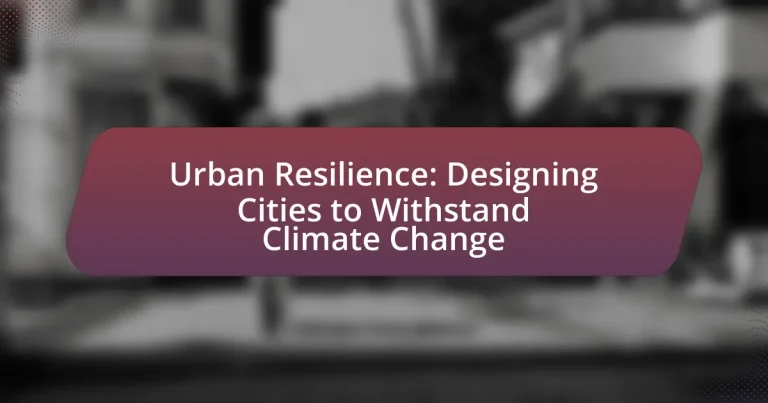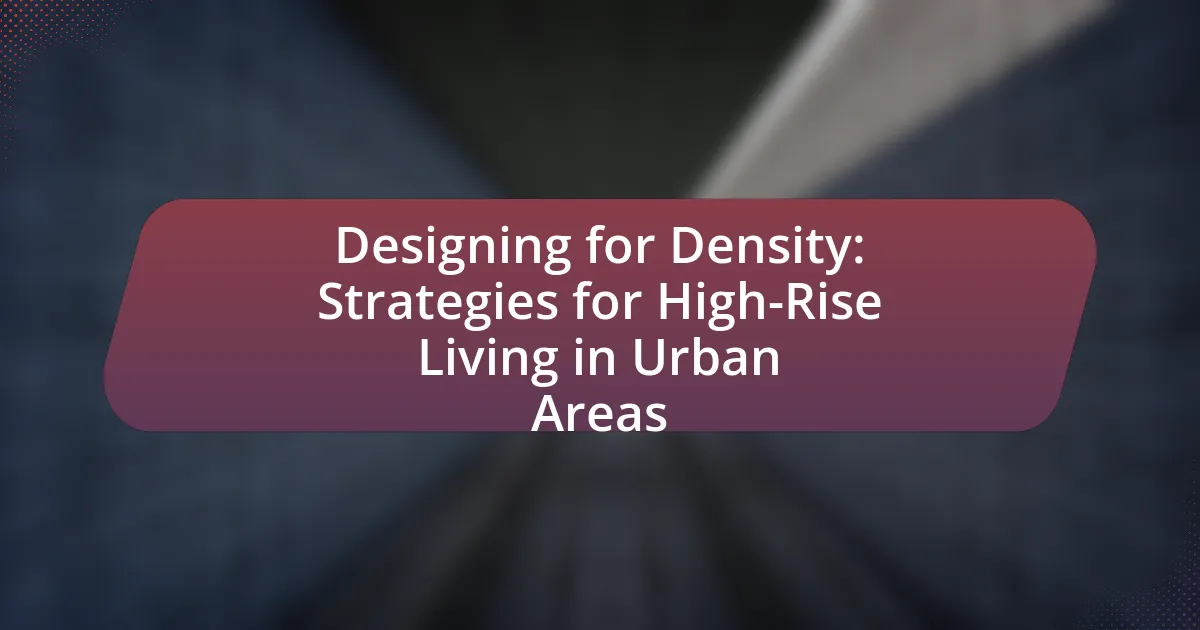Urban resilience refers to the ability of cities to anticipate, prepare for, respond to, and recover from climate-related hazards and stresses. This article explores the significance of urban resilience in sustainable city planning, highlighting key principles such as adaptability, diversity, integration, and sustainability. It contrasts urban resilience with traditional urban planning, emphasizing the need for proactive strategies that incorporate green infrastructure and community engagement to mitigate climate change impacts. The article also discusses the main threats posed by climate change to urban areas, effective strategies for designing resilient cities, and the role of community involvement in enhancing resilience. Additionally, it addresses the challenges and financial barriers cities face in implementing resilience strategies, while outlining best practices for improving urban resilience through policy integration and social equity considerations.
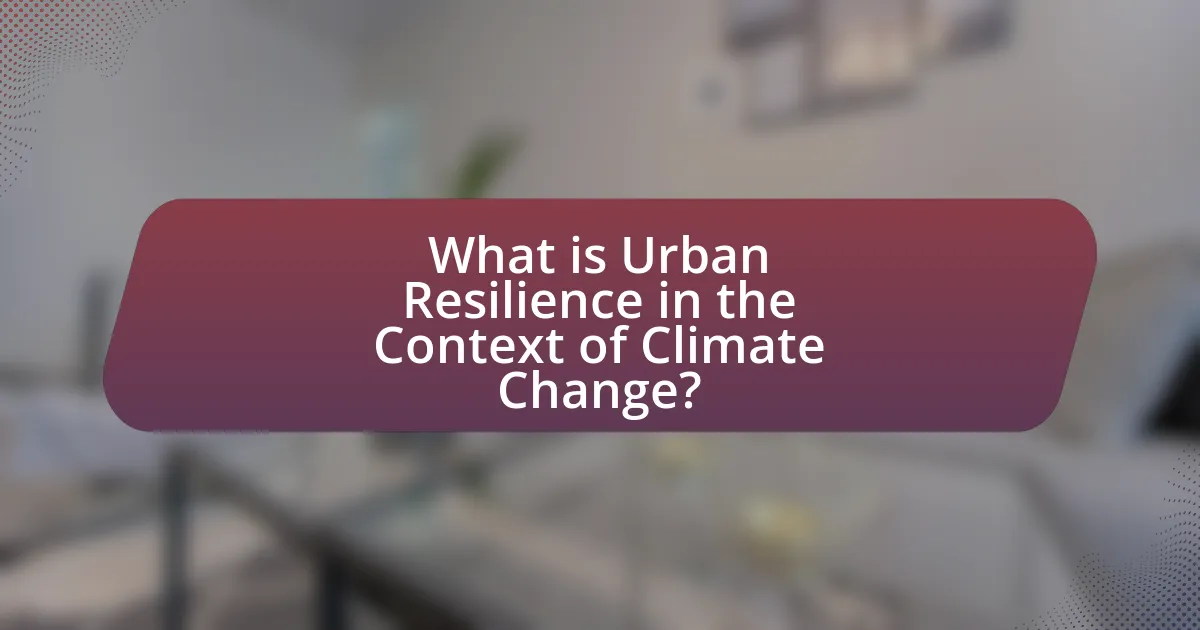
What is Urban Resilience in the Context of Climate Change?
Urban resilience in the context of climate change refers to the capacity of urban areas to anticipate, prepare for, respond to, and recover from climate-related hazards and stresses. This concept emphasizes the importance of adaptive strategies, infrastructure improvements, and community engagement to mitigate the impacts of climate change, such as flooding, heatwaves, and sea-level rise. Evidence from the Intergovernmental Panel on Climate Change (IPCC) highlights that cities are increasingly vulnerable to climate risks, necessitating robust urban planning and investment in resilient infrastructure to protect populations and economies.
How does Urban Resilience contribute to sustainable city planning?
Urban resilience contributes to sustainable city planning by enhancing a city’s ability to anticipate, prepare for, respond to, and recover from adverse events, particularly those related to climate change. This proactive approach integrates risk management and sustainability principles, ensuring that urban infrastructure and services can withstand environmental stresses. For instance, cities that adopt green infrastructure, such as permeable pavements and urban forests, not only mitigate flooding but also improve air quality and biodiversity, aligning with sustainable development goals. Research from the United Nations indicates that resilient cities can reduce economic losses from disasters by up to 50%, demonstrating the financial viability of investing in urban resilience as a core component of sustainable city planning.
What are the key principles of Urban Resilience?
The key principles of Urban Resilience include adaptability, diversity, integration, and sustainability. Adaptability allows urban systems to adjust to changing conditions and recover from disturbances, as seen in cities that implement flexible infrastructure designs. Diversity enhances resilience by ensuring a variety of options and resources, which can be observed in ecosystems where biodiversity contributes to stability. Integration emphasizes the interconnectedness of urban systems, promoting collaboration among stakeholders to create cohesive strategies, evident in successful urban planning initiatives. Sustainability focuses on long-term viability, ensuring that urban development meets present needs without compromising future generations, as demonstrated by cities adopting green building practices and renewable energy sources.
How does Urban Resilience differ from traditional urban planning?
Urban resilience focuses on a city’s ability to adapt and recover from environmental shocks, while traditional urban planning primarily emphasizes land use, infrastructure, and development without necessarily accounting for climate change impacts. Urban resilience incorporates strategies such as green infrastructure, community engagement, and adaptive governance to enhance a city’s capacity to withstand and recover from disasters, as evidenced by the increasing integration of resilience frameworks in city planning documents globally. In contrast, traditional urban planning often follows a more static approach, concentrating on zoning and transportation systems without prioritizing flexibility or sustainability in the face of climate-related challenges.
Why is Urban Resilience critical for modern cities?
Urban resilience is critical for modern cities because it enables them to effectively withstand and recover from climate-related shocks and stresses. As urban areas face increasing threats from extreme weather events, rising sea levels, and other climate impacts, resilience strategies help mitigate damage and ensure continuity of essential services. For instance, cities that invest in green infrastructure, such as parks and permeable surfaces, can reduce flooding and improve air quality, thereby enhancing public health and safety. According to the Intergovernmental Panel on Climate Change, urban areas are responsible for approximately 70% of global greenhouse gas emissions, making resilience not only a local concern but a global imperative for sustainable development.
What are the main threats posed by climate change to urban areas?
The main threats posed by climate change to urban areas include increased flooding, heatwaves, and air quality deterioration. Urban areas are particularly vulnerable due to high population density and infrastructure that is often not designed to withstand extreme weather events. For instance, rising sea levels can lead to more frequent and severe flooding, affecting millions of residents in coastal cities. According to the Intergovernmental Panel on Climate Change (IPCC), urban flooding is expected to increase by 50% by 2050 due to climate change. Additionally, heatwaves are projected to become more intense and frequent, with urban heat islands exacerbating the effects, leading to health risks such as heat-related illnesses. Furthermore, climate change contributes to worsening air quality, as higher temperatures can increase ground-level ozone, which poses respiratory risks. These threats necessitate urgent action to enhance urban resilience and adapt infrastructure to mitigate the impacts of climate change.
How can Urban Resilience mitigate these threats?
Urban resilience can mitigate threats from climate change by enhancing infrastructure, improving emergency response systems, and fostering community engagement. By investing in resilient infrastructure, cities can withstand extreme weather events, as evidenced by the implementation of green roofs and permeable pavements that reduce flooding. Improved emergency response systems, such as early warning systems and evacuation plans, enable quicker reactions to disasters, thereby minimizing damage and loss of life. Additionally, fostering community engagement through education and participatory planning empowers residents to adapt to climate challenges, as seen in cities like Rotterdam, which actively involve citizens in resilience-building initiatives. These strategies collectively strengthen urban areas against the impacts of climate change.
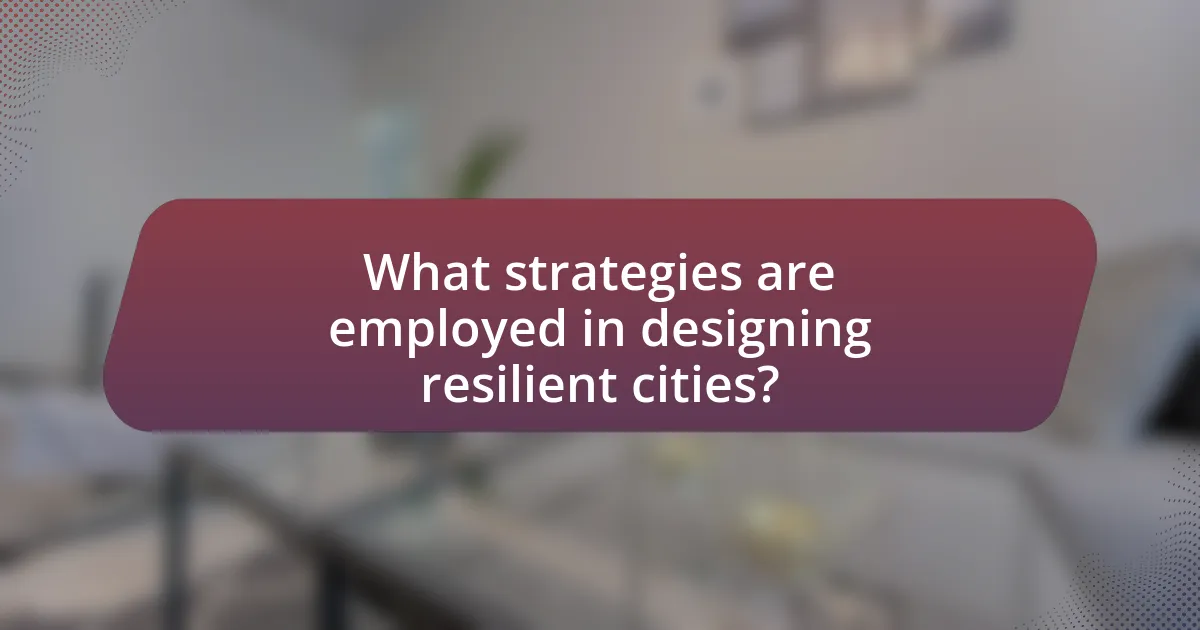
What strategies are employed in designing resilient cities?
Resilient cities are designed using strategies such as integrated urban planning, green infrastructure, and community engagement. Integrated urban planning involves creating land-use policies that prioritize sustainability and adaptability to climate impacts, ensuring that urban development aligns with environmental considerations. Green infrastructure, including parks, green roofs, and permeable surfaces, helps manage stormwater, reduce urban heat, and enhance biodiversity. Community engagement is crucial, as it involves local populations in decision-making processes, fostering a sense of ownership and ensuring that resilience strategies meet the specific needs of residents. These strategies are supported by research indicating that cities employing such approaches can better withstand climate-related challenges, as evidenced by case studies from cities like Rotterdam and New York, which have successfully implemented these methods to enhance their resilience.
How do green infrastructure and nature-based solutions enhance Urban Resilience?
Green infrastructure and nature-based solutions enhance urban resilience by improving ecosystem services, reducing vulnerability to climate impacts, and promoting sustainable urban development. These approaches, such as green roofs, permeable pavements, and urban forests, mitigate flooding by absorbing rainwater, thus decreasing runoff and the risk of urban flooding. For instance, a study by the National Oceanic and Atmospheric Administration (NOAA) found that green infrastructure can reduce stormwater runoff by up to 65%, significantly lowering flood risks in urban areas. Additionally, these solutions improve air quality and reduce urban heat islands, contributing to better public health and energy efficiency. By integrating natural systems into urban planning, cities can adapt to climate change more effectively, ensuring long-term sustainability and resilience.
What are examples of green infrastructure in urban settings?
Examples of green infrastructure in urban settings include green roofs, permeable pavements, rain gardens, urban forests, and green walls. Green roofs reduce stormwater runoff and improve energy efficiency by insulating buildings. Permeable pavements allow water to infiltrate, reducing flooding and improving groundwater recharge. Rain gardens capture and filter stormwater, enhancing water quality. Urban forests provide shade, improve air quality, and support biodiversity. Green walls contribute to building insulation and enhance urban aesthetics. These elements collectively enhance urban resilience against climate change impacts by managing stormwater, reducing heat, and improving air quality.
How do nature-based solutions reduce urban heat and flooding?
Nature-based solutions reduce urban heat and flooding by enhancing green spaces, which provide shade and improve water absorption. Urban vegetation, such as trees and green roofs, lowers surface temperatures through evapotranspiration, effectively mitigating the urban heat island effect. Additionally, these green areas absorb rainwater, reducing runoff and the risk of flooding. For instance, a study by the National Oceanic and Atmospheric Administration found that urban trees can lower surrounding air temperatures by up to 10 degrees Fahrenheit, while green infrastructure can reduce stormwater runoff by 30% to 50%.
What role does community engagement play in Urban Resilience?
Community engagement is crucial for urban resilience as it fosters collaboration, enhances local knowledge, and builds social capital among residents. Engaged communities are better equipped to identify vulnerabilities, develop adaptive strategies, and implement solutions tailored to their specific needs. Research indicates that cities with strong community involvement in resilience planning experience improved outcomes during climate-related events, as seen in the case of New Orleans post-Hurricane Katrina, where community-led initiatives significantly contributed to recovery efforts. Thus, active participation of residents not only empowers them but also strengthens the overall resilience of urban areas against climate change impacts.
How can local communities contribute to resilience planning?
Local communities can contribute to resilience planning by actively participating in decision-making processes and sharing local knowledge. Engaging community members allows for the identification of unique vulnerabilities and strengths, which can inform tailored resilience strategies. For instance, studies show that community-driven initiatives, such as neighborhood disaster preparedness programs, enhance local capacity to respond to climate-related events. Research from the National Academies of Sciences indicates that when communities are involved in resilience planning, they are more likely to adopt and implement effective measures, leading to improved outcomes during climate crises.
What are effective methods for involving citizens in resilience initiatives?
Effective methods for involving citizens in resilience initiatives include participatory planning, community workshops, and the use of digital platforms for engagement. Participatory planning allows citizens to actively contribute to decision-making processes, ensuring their needs and perspectives are considered. Community workshops facilitate dialogue and knowledge sharing, empowering residents to collaborate on local resilience strategies. Digital platforms, such as social media and dedicated apps, enhance communication and provide accessible channels for feedback and information dissemination. Research indicates that cities employing these methods, like New York and Copenhagen, have seen increased citizen engagement and more effective resilience outcomes.
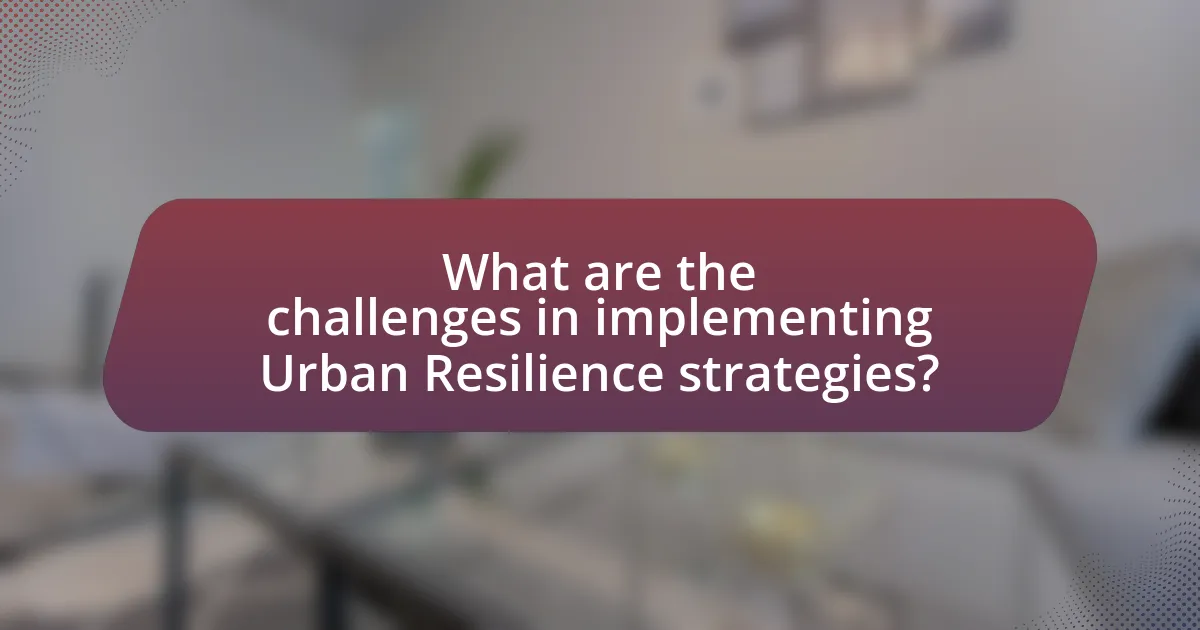
What are the challenges in implementing Urban Resilience strategies?
The challenges in implementing Urban Resilience strategies include funding limitations, stakeholder coordination, and data availability. Funding limitations hinder the ability to invest in necessary infrastructure and programs, as cities often face budget constraints. Stakeholder coordination is essential for successful implementation, yet differing priorities among government agencies, private sectors, and communities can create conflicts and slow progress. Additionally, data availability poses a challenge, as accurate and comprehensive data is crucial for assessing vulnerabilities and planning effective resilience measures. Without reliable data, cities struggle to make informed decisions, which can lead to ineffective strategies.
What financial barriers exist for cities pursuing Urban Resilience?
Cities pursuing Urban Resilience face significant financial barriers, including limited budgets, high upfront costs for infrastructure improvements, and insufficient funding from federal or state sources. Many municipalities operate under tight fiscal constraints, which restrict their ability to allocate funds for long-term resilience projects. For instance, a report from the National League of Cities indicates that nearly 60% of cities cite budget limitations as a primary obstacle to implementing climate adaptation strategies. Additionally, the initial investment required for resilient infrastructure, such as flood defenses or green spaces, can deter cities from pursuing necessary upgrades, especially when immediate financial returns are not evident.
How can cities secure funding for resilience projects?
Cities can secure funding for resilience projects by leveraging a combination of federal grants, public-private partnerships, and community engagement initiatives. Federal programs, such as the Federal Emergency Management Agency’s Building Resilient Infrastructure and Communities (BRIC) grant, provide financial resources specifically aimed at enhancing resilience against climate-related disasters. Public-private partnerships can attract investment from businesses that benefit from resilient infrastructure, while community engagement ensures local support and can lead to additional funding opportunities through crowdfunding or local initiatives. According to the National League of Cities, cities that actively pursue these funding avenues can significantly increase their financial resources for resilience projects, thereby enhancing their capacity to adapt to climate change impacts.
What are the economic benefits of investing in Urban Resilience?
Investing in urban resilience yields significant economic benefits, including reduced disaster recovery costs and enhanced property values. For instance, cities that implement resilient infrastructure can save up to $4 for every $1 spent on resilience measures, as reported by the National Institute of Building Sciences. Additionally, resilient urban areas attract businesses and residents, leading to increased economic activity and job creation. A study by the World Bank found that investing in urban resilience can lead to a 10-20% increase in local economic output, demonstrating the direct correlation between resilience investments and economic growth.
How do political and social factors influence Urban Resilience efforts?
Political and social factors significantly influence Urban Resilience efforts by shaping policy decisions, resource allocation, and community engagement. Political stability and governance structures determine the effectiveness of urban planning and disaster response strategies, as seen in cities like Copenhagen, where strong political commitment has led to innovative climate adaptation measures. Social factors, including community cohesion and public awareness, impact the level of citizen participation in resilience initiatives; for example, cities with active community organizations often implement more effective resilience strategies, as demonstrated in New Orleans post-Hurricane Katrina. Thus, the interplay of political will and social dynamics is crucial for fostering robust Urban Resilience frameworks.
What role do policies play in shaping Urban Resilience initiatives?
Policies are crucial in shaping Urban Resilience initiatives by providing frameworks and guidelines that govern how cities prepare for and respond to climate change impacts. These policies establish priorities for resource allocation, set standards for infrastructure development, and promote sustainable practices that enhance a city’s ability to withstand environmental stresses. For instance, the adoption of policies like the Paris Agreement encourages local governments to implement climate action plans that integrate resilience strategies, thereby fostering collaboration among stakeholders and ensuring that urban planning incorporates climate adaptation measures.
How can social equity be integrated into resilience planning?
Social equity can be integrated into resilience planning by ensuring that vulnerable populations have equal access to resources, decision-making processes, and benefits from resilience initiatives. This integration involves conducting equity assessments to identify disparities, engaging marginalized communities in planning processes, and prioritizing investments in areas most affected by climate change. For instance, the National Institute of Standards and Technology emphasizes the importance of inclusive stakeholder engagement to address the needs of diverse populations in resilience strategies. By incorporating these practices, resilience planning can effectively reduce inequalities and enhance community resilience against climate impacts.
What are best practices for enhancing Urban Resilience?
Best practices for enhancing urban resilience include integrating green infrastructure, improving building codes, and fostering community engagement. Green infrastructure, such as parks and green roofs, helps manage stormwater and reduce urban heat, as evidenced by studies showing a 30% reduction in flooding in cities that implemented such systems. Strengthening building codes ensures structures can withstand extreme weather events, with research indicating that cities with stringent codes experience 50% fewer damages during hurricanes. Community engagement fosters local knowledge and preparedness, leading to more effective disaster response, as demonstrated by cities that involve residents in resilience planning seeing a 40% increase in community readiness.
How can cities assess their current resilience levels?
Cities can assess their current resilience levels by conducting comprehensive vulnerability assessments that evaluate their exposure to climate-related risks and their capacity to adapt. This process typically involves analyzing infrastructure, social systems, and environmental factors to identify weaknesses and strengths. For instance, the 100 Resilient Cities initiative provides a framework that cities can use to measure resilience through indicators such as infrastructure robustness, emergency preparedness, and community engagement. Additionally, cities can utilize tools like the Resilience Index, which quantifies resilience across various dimensions, allowing for targeted improvements based on specific vulnerabilities identified in the assessment.
What steps can urban planners take to improve resilience in their designs?
Urban planners can improve resilience in their designs by incorporating green infrastructure, enhancing building codes, and promoting mixed-use developments. Green infrastructure, such as permeable pavements and green roofs, helps manage stormwater and reduce urban heat, which is crucial in mitigating climate change impacts. Strengthening building codes ensures structures can withstand extreme weather events, as evidenced by the 2017 hurricanes that highlighted vulnerabilities in existing buildings. Additionally, promoting mixed-use developments fosters community engagement and reduces reliance on transportation, which can lower carbon emissions and enhance social resilience. These strategies collectively contribute to creating urban environments that are better equipped to adapt to and recover from climate-related challenges.
